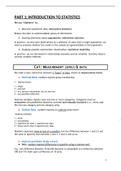Summary
Summary Applied Statistics I (424023-B-6) - STATISTICS PART
- Course
- Institution
- Book
This summary covers all subjects seen in the statistics class given by Luc van Baest. However, it doesn't cover the methodology and SPSS part, so I recommend you take a look at the bundle that includes all three summaries (Statistics + Methodology + SPSS)
[Show more]




